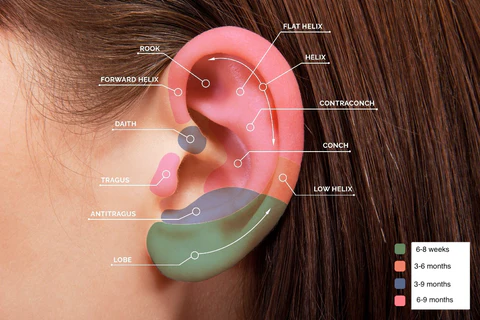
When Can I Change My Ear Piercing? A Safe Timeline & Tips
Changing your ear piercing jewelry is an exciting milestone, but it’s crucial to ensure your piercing has healed properly to prevent complications. Here’s a comprehensive guide on when and how to safely change your earrings, along with expert tips for a smooth transition.
Understanding the Healing Process
Ear piercings undergo a healing process that can be divided into three primary phases:
Inflammatory Phase: This initial phase starts immediately after the piercing and lasts approximately two to four days. During this time, you may experience swelling, redness, warmth, and mild pain at the piercing site. These symptoms are part of the body’s natural response to protect against infection and initiate healing.
Proliferative Phase: Beginning around day three and overlapping with the inflammatory phase, this stage involves the production of new skin tissue. The body generates new skin cells to repair the pierced area, gradually closing the wound.
Remodeling Phase: The final phase, where the new tissue strengthens and matures, can last several months. Although the surface may appear healed, the underlying tissue continues to solidify.
Source: heyrowan.com
Recommended Waiting Periods
The appropriate time to wait before changing your earrings depends on the type of piercing:
Earlobe Piercings: Typically, earlobe piercings heal faster than cartilage piercings. It’s generally recommended to wait at least six to eight weeks before changing earrings. However, some professionals advise waiting even longer to ensure complete healing.
Cartilage Piercings: These piercings, located in the harder area of the ear, require more time to heal due to reduced blood flow. It’s advisable to wait between 6 to 12 months before changing jewelry to minimize the risk of complications.
Source: Glam
Risks of Changing Earrings Too Early
Altering your earrings before the piercing has fully healed can lead to several issues:
Infection: Introducing new jewelry into an unhealed piercing increases the risk of bacterial contamination, potentially leading to infection.
Irritation and Inflammation: Premature changes can cause unnecessary trauma to the healing tissue, resulting in prolonged redness, swelling, and discomfort.
Delayed Healing: Disturbing the piercing site too soon can disrupt the healing process, extending the time required for complete recovery.
Source: Lackore Couture
Signs Your Piercing Has Healed
Before changing your earrings, ensure your piercing has fully healed by checking for the following signs:
Absence of Pain: No tenderness or discomfort when touching the area.
No Redness or Swelling: The skin around the piercing appears normal without signs of inflammation.
Dryness: No discharge or crusting present.
Mobility: The earring moves freely without resistance or pain.
It’s essential to note that individual healing times can vary. Even if these signs are present, it’s advisable to consult with your piercer before making any changes.
Expert Tips for Changing Your Earrings Safely
Once you’ve confirmed that your piercing has healed, follow these steps to change your earrings safely:
Wash Your Hands: Thoroughly clean your hands with soap and water to prevent introducing bacteria to the piercing site.
Clean the Piercing Area: Gently cleanse the area around the piercing with a saline solution or a piercing aftercare product to ensure it’s free from any debris.
Remove the Old Earring Carefully: Slowly and gently remove the existing earring, avoiding any sudden movements that could irritate the piercing.
Insert the New Earring: Choose hypoallergenic jewelry made from materials like surgical steel, titanium, or 14k gold to minimize the risk of allergic reactions. Gently insert the new earring, ensuring it’s secured properly without being too tight.
Monitor the Piercing: After changing the earring, keep an eye on the piercing for any signs of irritation or infection. If you notice redness, swelling, or discomfort, consult with a professional piercer or healthcare provider.
Conclusion
Patience is key when it comes to changing your ear piercing jewelry. Adhering to recommended healing times and following proper aftercare procedures will ensure a smooth transition and maintain the health of your piercing. Always consult with a professional piercer if you’re uncertain about the healing status or the process of changing your earrings.

